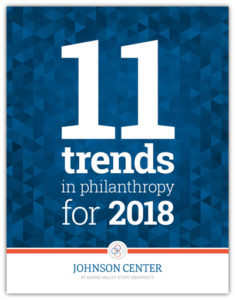Defining Progress With Place-Based Philanthropy


Download and read the full report, featuring all 11 trends, here.
 We noted last year in our 11 Philanthropic Trends for 2017 that there has been a resurgence of interest in place-based philanthropy with a focus on systems change. Place-based philanthropy is focused on a defined geography. Depending on the funder and the particular issues being addressed, the place might range from a single neighborhood to a whole city to a larger multi-state region. This year, the trend continues unabated: grantmakers of all types are bringing deeper insights into place-based work and new tools and strategies to bear on efforts to improve outcomes for all members of communities (Brown, 2017).
We noted last year in our 11 Philanthropic Trends for 2017 that there has been a resurgence of interest in place-based philanthropy with a focus on systems change. Place-based philanthropy is focused on a defined geography. Depending on the funder and the particular issues being addressed, the place might range from a single neighborhood to a whole city to a larger multi-state region. This year, the trend continues unabated: grantmakers of all types are bringing deeper insights into place-based work and new tools and strategies to bear on efforts to improve outcomes for all members of communities (Brown, 2017).
The focus on place brings together a number of other trends in the field for several reasons. First, the complexity of creating measurable change on an issue at a national level is daunting — if not impossible. In seeking to be more strategic in their giving, funders are choosing to concentrate their efforts in a particular geography to increase the probability of both creating change and being able to measure it. Giving within a defined geographic area puts boundaries on where to look for change.
Second, recognition of the complexity and interconnectedness of people’s lives has led to an increased emphasis on creating systems change (Kramer, 2017). The lives of people in communities are impacted by a variety of systems that interact together more or less effectively. The education and healthcare systems, for example, both have an influence on academic outcomes. Focusing giving in a particular place helps to define and put boundaries around the systems one hopes to change.
Third, we know that the most effective and sustainable change happens when there is broad participation in defining problems and creating solutions (e.g. Lasker, 1997; Israel, Schulz, Parker, & Becker, 1998). Place-based work provides a way to identify who should participate and takes socioeconomic, political, cultural, and other contextual factors into account.
Increasingly, we are seeing some new twists to place-based work. For example, it is not just foundations or large donors who are turning to this strategy. New research on giving circles shows that there has been significant growth in the number of these collaboratives and that the majority of them are giving to their local community rather than to issues at a national scale (Bearman, Carboni, Eikenberry, & Franklin, 2017).
Another twist is the increasing emphasis on impact investing as a strategy for local economic development. Colorado Impact Days, Local First, and Mission Investors Exchange are examples of efforts to bring other forms of capital besides philanthropic grants to bear on creating positive social change at a community level. The biggest gathering of the year related to impact investing, SoCap17, included a strong emphasis on communities (Onek, 2017).
A third new angle on place-based work is an emphasis on sustainability. This is a global trend, with work going on both in the U.S. and internationally (Thomashow, 2017). The U.K.-based Ellen MacArthur Foundation, for example, is promoting the concept of circular economies — economies that maximize local benefit and recycle resources within a community.
We anticipate that the trend toward place-based work will continue into the foreseeable future. This approach to philanthropy and, more broadly, to economic and community development, seems to cut across ideologies, with something to recommend to everyone from populists to environmentalists.
Bearman, J., Carboni, J., Eikenberry, A., & Franklin, J. (2017). The landscape of giving circles/collective giving groups in the U.S. Grand Rapids, MI: Collective Giving Research Group. Retrieved from http://johnsoncenter.org/wp-content/uploads/2017/11/Giving-Circles-Research-Full-Report-1-WEB.pdf
Brown, P. (2017). Effective place-based philanthropy: The role and practices of a national funder. The Democracy Fund. Retrieved November 28, 2017 from http://www.democracyfund.org/publications/effective-place-based-philanthropy
Israel, B. A., Schulz, A. J., Parker, E. A., & Becker, A. B. (1998). Review of community-based research: assessing partnership approaches to improve public health. Annual Review of Public Health, 19(1), 173–202. Retrieved from https://doi.org/10.1146/annurev.publhealth.19.1.173
Lasker, R. D. (1997). Committee on Medicine and Public Health. Medicine and Public Health: the Power of Collaboration. Chicago, IL: Health Administration Press.
Kramer, M. R. (2017, April 11). Systems change in a polarized country. Retrieved from https://ssir.org/articles/entry/systems_change_in_a_polarized_country
Onek, M. (2017, October). Top 4 takeways from SoCap17. Mission Investors Exchange. Retrieved from https://missioninvestors.org/resources/top-4-takeaways-socap17
Thomashow, M. (2017, March 13). Place-based philanthropy supports urban sustainability. Philanthropy Northwest. Retrieved from https://philanthropynw.org/news/place-based-philanthropy-supports-urban-sustainability